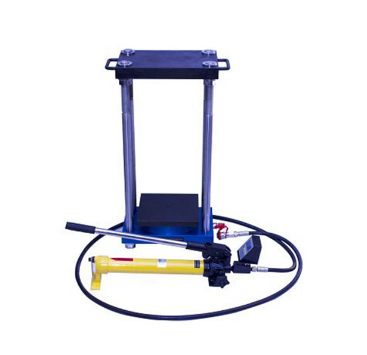
咨询服务热线: 0514-87885777

腾达试验仪器厂:
原位压力机是检测仪器,适用于推定240mm厚普通砖砌体的抗压强度,是现场检测砖砌体抗压强度综合评定的A设备。使用前务必仔细阅读说明书。并由**实验人员操作,以避免操作不当引起的伤害。如需了解更多资料请与我公司客服人员联系。原位压力机具有吨位大、行程高、不漏油、使用方便并有数字显示表、示值**、保留峰值特点,由上海荣计达仪器科技有限公司提供,设备质保期一年,一年内产品如有质量问题,供方负责免费维修。如果因操作不当或者人为损坏,我公司亦应提供维修、更换服务,由此产生的费用我公司会酌情收取。
The in-situ press is a testing instrument that is suitable for estimating the compressive strength of 240mm thick ordinary brickwork.It is an A device for comprehensive assessment of the compressive strength of brickwork on the spot.Be sure to read the instructions carefully before use.It is operated by**experimental personnel to avoid injury caused by improper operation.For more information,please contact our customer service staff.The in-situ press has the characteristics of large tonnage,high stroke,no oil leakage,convenient use,digital display meter,indication value**,and peak retention.It is provided by Shanghai Rongjida Instrument Technology Co.,Ltd.If there is any quality problem during the year,the supplier is responsible for free maintenance.If due to improper operation or man-made damage,our company should also provide repair and replacement services,and the costs incurred by our company will be charged as appropriate.
SL-80原位压力机主要技术指标:
★本设备由扁式千斤顶、四根强力拉杆、上压板、下压板、球头垫、手泵压力杆、★数显表或防震压力表、回位压兰等部件
★额定压力:800KN
★极限压力:1000KN
★A大行程:20mm
★极限行程:25mm
★示值相对误差:?%
★上压板平面尺寸:370mmX240mm
★设备总重量:104kg、其中扁式千斤顶57kg
★下压板尺寸:240mmX240mm
★贮油量:1.5升
★扁式千斤顶主缸直径:168mm
Main technical indicators of SL-80 in-situ press:
★This equipment consists of flat jack,four strong pull rods,upper pressure plate,lower pressure plate,ball head pad,hand pump pressure rod,
★Rated pressure:800KN
★Ultimate pressure:1000KN
★A large stroke:20mm
★Extreme travel:25mm
★Relative error of displayed value:?%
★Plane size of upper platen:370mmX240mm
★Total weight of the equipment:104kg,including 57kg flat jack
★The size of the lower plate:240mmX240mm
★Oil storage capacity:1.5 liters
★Flat jack master cylinder diameter:168mm
SL-80原位压力机测定方法:
1、先在墙体上开凿两条水平槽孔①上水平槽尺寸应为240mm×250mm×70mm(深×宽×高)②下水平槽尺寸为240mm×250mm×140m(深×宽×高),(下槽的高度视压力机型号不同而调整)③上下水平槽孔对齐,两槽间相隔7皮砖,净距约430mm④槽间砌体的承压面修平整
2、安放原位压力机①在上槽下表面和扁式千斤顶的顶面,均匀铺设厚10mm湿细砂垫层或石膏等其他材料,便于均匀受力②将反力板置于上槽孔及扁式千斤顶置于下槽孔,并使两个承压板上下对齐后,拧紧螺母并调整其平行度
3、试加荷载检查测试系统是否灵敏以及上下压板和砌体受压面接触是否均匀密实,待正常后卸荷即开始测试。4、正式测试分级加荷,每级荷载约为预估破坏荷载的10%,加至预估破坏荷载的80%,连续加荷直至槽间砌体破坏(当槽间砌体裂缝急剧扩展而压力表指针明显回退时,即为槽间砌体的破坏荷载)。
5、将破坏荷载换算成槽间砌体的抗压强度和标准砌体抗压强度,再与设计值对比,从而判明现有砌体的真实强度。
6、数据分析。
SL-80 in-situ press determination method:
1.First cut two horizontal slot holes in the wall.①The upper horizontal slot size should be 240mm×250mm×70mm(depth×width×height).②The lower horizontal slot size should be 240mm×250mm×140m(depth×width×high).,(The height of the lower groove is adjusted according to the type of the press)③The upper and lower horizontal grooves are aligned,and the two grooves are separated by 7 leather bricks with a clear distance of about 430mm.
2.Place the in-situ press①On the lower surface of the upper groove and the top surface of the flat jack,evenly lay a 10mm thick wet sand cushion or gypsum and other materials to facilitate uniform stress②Place the reaction force plate in the upper groove hole And flat jack are placed in the lower slot,and the two pressure plates are aligned up and down,tighten the nut and adjust its parallelism
3.Trial load test Check whether the test system is sensitive and whether the upper and lower pressure plates and the contact surface of the masonry are uniform and dense.After the load is normal,the test is started.4.Formal test of formal loading,each load is about 10%of the estimated damage load,added to 80%of the estimated damage load,and continuously loaded until the masonry between the grooves is damaged When the pointer of the pressure gauge retreats obviously,it is the damage load of the masonry between the grooves).
5.Convert the damage load into the compressive strength of the masonry between the grooves and the compressive strength of the standard masonry,and then compare it with the design value to determine the true strength of the existing masonry.
6.Data analysis.
微信扫一扫
